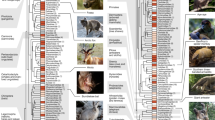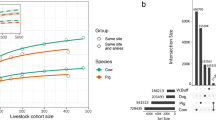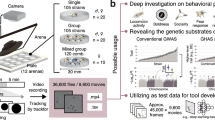Abstract
Stock centres for our animal models are as important as other scientific resources, such as the primary literature or genome databases. But they need forward planning, international cooperation and secure funding to keep pace with the explosion in functional genomics that relies so heavily on them.
This is a preview of subscription content, access via your institution
Access options
Subscribe to this journal
Receive 12 print issues and online access
$259.00 per year
only $21.58 per issue
Buy this article
- Purchase on SpringerLink
- Instant access to full article PDF
Prices may be subject to local taxes which are calculated during checkout
Similar content being viewed by others
References
Ashburner, M. Europe must grant crucial funds for biological research. Nature 402, 12 (1999).
Wang, W. B., Leopold, R. A., Nelson, D. R. & Freeman, T. P. Cryopreservation of Musca domestica (Diptera: Muscidae) embryos. Cryobiology 41, 153–166 (2000).
Leopold, R. A., Wang, W. B., Berkebile, D. R. & Freeman, T. P. Cryopreservation of embryos of the New World screworm Cochliomyia hominovorax (Diptera: Calliphoridae). Ann. Entomol. Soc. Am. 94, 695–701 (2001).
Glenister, P. H. & Thornton, C. E. Cryoconservation — archiving for the future. Mamm. Genome 11, 565–571 (2000).
Balling, R. ENU mutagenesis: analyzing gene function in mice. Annu. Rev. Genomics Hum. Genet. 2, 463–492 (2001).
Nadeau, J. H. Modifier genes in mice and humans. Nature Rev. Genet. 2, 165–174 (2001).
Balmain, A. Cancer as a complex genetic trait: tumor susceptibility in humans and mouse models. Cell 108, 145–152 (2002).
Bucan, M. & Abel, T. The mouse: genetics meets behaviour. Nature Rev. Genet. 3, 114–123 (2002).
Paigen, K. & Epping, J. T. A mouse phenome project. Mamm. Genome 11, 715–717 (2000).
Eppig, J. T. Algorithms for mutant sorting: the need for phenotype vocabularies. Mamm. Genome 11, 584–589 (2000).
Nadeau, J. H. et al. Sequence interpretation. Functional annotation of mouse genome sequences. Science 291, 1251–1255 (2001).
Eppig, J. T. & Strivens, M. Finding a mouse: The International Mouse Strain Resource (IMSR). Trends Genet. 15, 81–82 (1999).
Acknowledgements
The helpful comments of K. Matthews, S. Brown, N. Jenkins, J. Eppig and M. Hrabe de Angelis are gratefully acknowledged.
Author information
Authors and Affiliations
Corresponding author
Related links
Glossary
- ALLELIC SERIES
-
A series of different genotypes, or alleles, at a specific gene locus, that are associated with different phenotypes.
- BALANCER CHROMOSOME
-
A chromosome with one or more inverted segments that suppress recombination, ideally over the length of the chromosome. The balancer is usually identified in crosses by a dominant marker and carries at least one recessive lethal mutation. They are used as genetic tools because they allow lethal mutations to be maintained without selection, as the only offspring that will be viable from an intercross will be those that carry the mutation and are heterozygous for the balancer chromosome.
- P-ELEMENTS
-
A family of transposable elements that are widely used as the basis of tools for mutating and manipulating the Drosophila genome.
- PENETRANCE
-
The frequency with which individuals that carry a given gene will show the manifestations associated with the gene. If penetrance of a disease allele is 100% then all individuals carrying that allele will express the associated disorder.
Rights and permissions
About this article
Cite this article
Rosenthal, N., Ashburner, M. Taking stock of our models: the function and future of stock centres. Nat Rev Genet 3, 711–717 (2002). https://doi.org/10.1038/nrg891
Issue date:
DOI: https://doi.org/10.1038/nrg891
This article is cited by
-
High-speed camera recordings uncover previously unidentified elements of zebrafish mating behaviors integral to successful fertilization
Scientific Reports (2021)
-
New technologies to assess genotype–phenotype relationships
Nature Reviews Genetics (2003)



